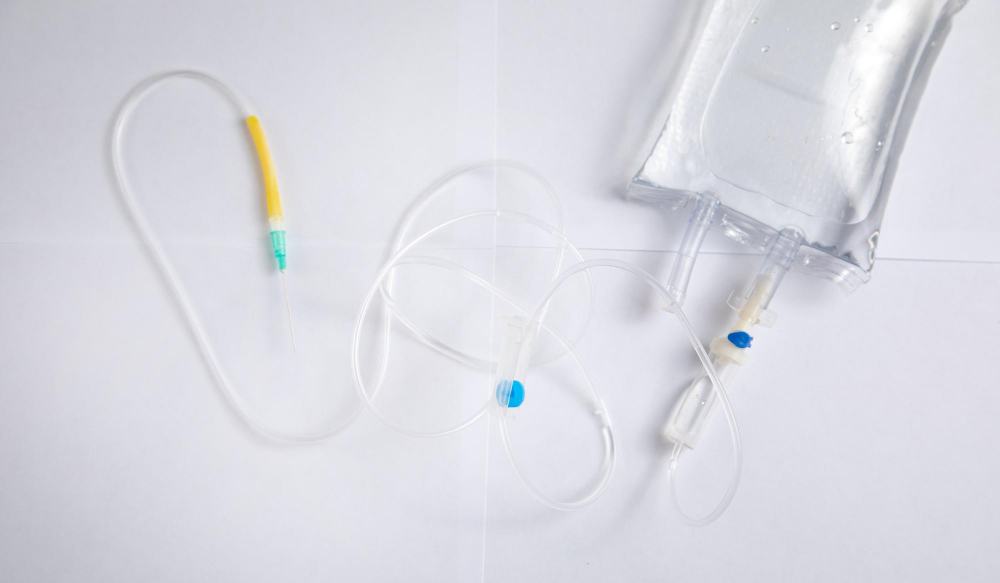Whether it is replenishing lost fluids, correcting electrolyte imbalances, or injuries, IV therapy plays a significant role in controlling the human body’s homeostasis. This type of therapy is quite popular due to the simple way of performing it and the reduced risk of complications. Understanding the different types of IV fluids and their composition will help you understand the entire procedure more easily.
Let’s explain the different IV fluid solutions, their purpose, and their function.
List of Types of IV Fluids
Several types of IV fluids are commonly used in daily medical practice. So, intending to make the general division, we will explain such fluids and their application. Accordingly, IV fluids can be divided into two major groups, crystalloids and colloids, with a few undertypes each.
But what are the 3 main types of IV fluids that are commonly used?
The three main types of crystalloid IV fluids are isotonic, hypotonic, and hypertonic IV solutions. Each of them has a different solution and nutrient content, providing different effects to the patient.

1. Isotonic Solutions
A characteristic of isotonic solutions is that they have the same osmotic pressure as blood cell. This composition of isotonic solutions allows them to maintain a balanced osmotic pressure with equal amounts of fluids outside and inside the cell. Such solutions may increase intravascular volume in conditions such as diarrhea, shock, metabolic acidosis, vomiting, etc. As the most popular isotonic solutions that are often used in medical practice are:
- Lactated Ringer
This isotonic solution is often found in ambulances, emergency rooms, and places where emergency cases are treated. Lactated Ringer may help patients with extensive blood loss or low blood pressure. Another variant of this isotonic solution is Ringer’s Solution, which, unlike Lactated Ringer, does not contain Sodium lactate (C3H5NaO3).
- 0.9% NaCl
Normal saline solution (0.9% NaCl) or NSS solution has an osmolarity of 308 mOsm/L and provides no calories. It is used to replace excessive sodium loss that results from burns or trauma.
- 5% dextrose in water
Such a solution belongs to both hypotonic and isotonic types. The main purpose of this solution is to provide free water when the dextrose is metabolized. The D5W solution has less than 200 calories and contains 50 grams of glucose. Such a solution is used for maintaining low blood sugar, insulin shock, and dehydration.
- PlasmaLyte (PL-148)
PL-148 or PlasmaLyte A infusion is used as a source of fluid intervention in cases of burns, infections, fractures, head injuries, during surgeries, and more. The solution is made of sodium chloride, potassium chloride, magnesium chloride, sodium acetate, and sodium gluconate. The composition of this solution is really close to human plasma.
2. Hypotonic Solutions
Hypotonic IV solutions feature low osmolarity and contain fewer solutes than the blood plasma. For an IV solution to be considered hypotonic, the total electrolyte content should not exceed 250 mEq/L. Based on the solution’s composition, hypotonic solutions are usually used to provide free water in case of excessive body waste, oftentimes in case of dehydration.
- 0.45% NaCl
In this solution, sodium chlorine or saline is the main component; 100-milliliter of Sodium Chloride solution contains 450 grams of sodium chloride in water. When applied intravenously, this type of solution provides a source of water and electrolytes.
The main use of this solution is to replace and maintain water and electrolyte levels in the body. However, patients with congestive heart failure, renal insufficiency, and other clinical states should not receive 0.45% NaCl without a doctor’s permission.
- 0.33% NaCl
0.33% Sodium Chloride solution is mainly used in patients with kidney issues. Administered with dextrose, this solution may allow kidneys to retain the necessary amounts of water. So, unlike 0.45% NaCl, this solution can be given to patients with kidney dysfunction but should not be given to patients with renal insufficiency or heart failure.
- 0.225% NaCl
Such a solution containing a low saline level may be combined with dextrose and used in pediatric health care.
- 2.5% Dextrose in water
2.5% dextrose in water may work in conditions like dehydration, reducing the level of sodium and potassium in the body.
3. Hypertonic Solutions
Unlike a hypotonic solution, a hypertonic solution has a higher sodium content and draws water from the cells instead of taking it in. This increased sodium content is ideal for replacing electrolytes but is not used in certain conditions such as dehydration. The most famous hypertonic solutions are:
- 5% NaCl
- 3% NaCl
- 5% dextrose in Lactated Ringer’s
- 5% dextrose in 0.45% NaCl
- 5% dextrose in 0.9% NaCl
- 10% dextrose in water
- 20% dextrose in water
- 50% dextrose in water
Osmolarity and Tonicity
To better understand the function of IV fluids, you need to know what osmolality and tonicity are. To help you find it out, we will define and explain these two phenomena and their effect on IV fluid in the body.
- Osmolarity refers to the concentration of osmotically active particles (such as ions, molecules, or compounds) in a solution. It is measured in milliosmoles per liter or mOsmol/L or milliosmoles per milliliter or mOsmol/mL. To perform IV therapy successfully, healthcare professionals need to know the osmolarity of the fluid before it is administered. Administering fluids that are outside the acceptable molarity range may cause side effects.
- Tonicity, on the other hand, refers to the ability of an extracellular solution to make water move into or out of a cell by osmosis, which allows water to pass through a semipermeable membrane.
Suppose the solution on one side of the membrane has a higher osmolarity than the solution on the other side. In that case, the water in the solution with lower osmolarity will flow through the membrane until the two solutions are of equal concentration. Accordingly, the IV fluid may cause water to flow out or into the cell. Side effects may occur if the solution is not within an acceptable osmolality range.

Conclusion
Regarding IV therapy, choosing the right IV fluid is one of the most important factors contributing to successful treatment. Whether it is a hypotonic, isotonic, or hypertonic solution, these IV Fluids may offer numerous benefits.
Being familiar with the characteristics and effects of different types of IV fluids is very important, especially to healthcare providers. By understanding the principles of safe administration and the benefits, they will more easily be able to optimize the results and contribute to improving the well-being of patients.
So, if you decide on this type of therapy, choose a reputable healthcare facility where IV therapy is administered by a licensed and experienced healthcare provider.



